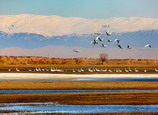
Scientists are scrambling to understand how a new bird flu virus emerged and whether it poses a public health risk or could potentially spark a pandemic.
The good news is that so far there's no sign that the H7N9 virus is spreading from person to person, but experts say it has mutated in a worrisome way.
Here's a crash course in Bird Flu 101.
Q: What is the H7N9 virus and what do we know about it?
A: The H7N9 strain - named for the combination of proteins on its surface - has infected at least 21 people in China since February, killing six. Symptoms include fever and respiratory problems, including severe pneumonia. Much is still unknown about the virus, including how people are getting infected, but scientists say it contains genetic markers that could help it infect humans. It is believedable to circulate in poultry stocks without sickening birds. This allows it to spread in flocks unnoticed, making it much harder to track and possibly creating more contamination since the birds are surviving and spending more time on farms, in markets and elsewhere.
Q: How concerned should we be?
A: At this point, experts say there is no cause for alarm, but they are watching closely. There's no evidence the virus spreads from person to person, and no cases have been reported outside China. Samples are collected from patients, and the Chinese Center for Disease Control and Prevention is sharing genetic sequences with the world's top flu experts. They study the virus and look for dangerous mutations. Poultry and its products are safe to eat as long as they are properly cooked.
Q: Is there a vaccine?
A: No vaccine exists, but the World Health Organization and its partners are working to isolate and identify possible candidate viruses that could make a future vaccine if necessary. It would likely take months to produce.
Q: What changes do scientists see in the virus and why is this important?
A: The virus appears to have mutated in a way that would make it easier for it to adapt and grow at normal body temperature in mammals. Scientists are trying to figure out which species could now be playing host to the virus, and one possibility is pigs.
Swine are important because they share some basic biological similarities with humans, and they can serve as "mixing vessels" if infected with different flu strains at the same time.
Mutations could also be occurring in poultry or are being generated after people are infected. "The most important question is: What is the virus' actual host?" said Richard Webby, director of a WHO flu center at St Jude Children's Research Hospital in Memphis, Tennessee. "It really looks like some mammalian host is involved."
Q: How is this bird flu different from the deadly H5N1 strain?
A: The H5N1 virus is highly lethal in birds, making it easier to identify and eliminate poultry outbreaks. H5N1 remains an avian influenza and has not taken root in another species, such as pigs. Most human infections have been linked to contact with infected birds. Scientists have been watching the virus since it first appeared in Hong Kong in 1997. It resurfaced in 2003, decimated poultry stocks across Asia and has since killed at least 371 people. About 60 percent of patients die, and experts have long feared this virus could mutate into a form that spreads easily between people, possibly igniting a pandemic.
















 Life aboard a fishing boat under bridge in city of Chongqing
Life aboard a fishing boat under bridge in city of Chongqing


![]()
